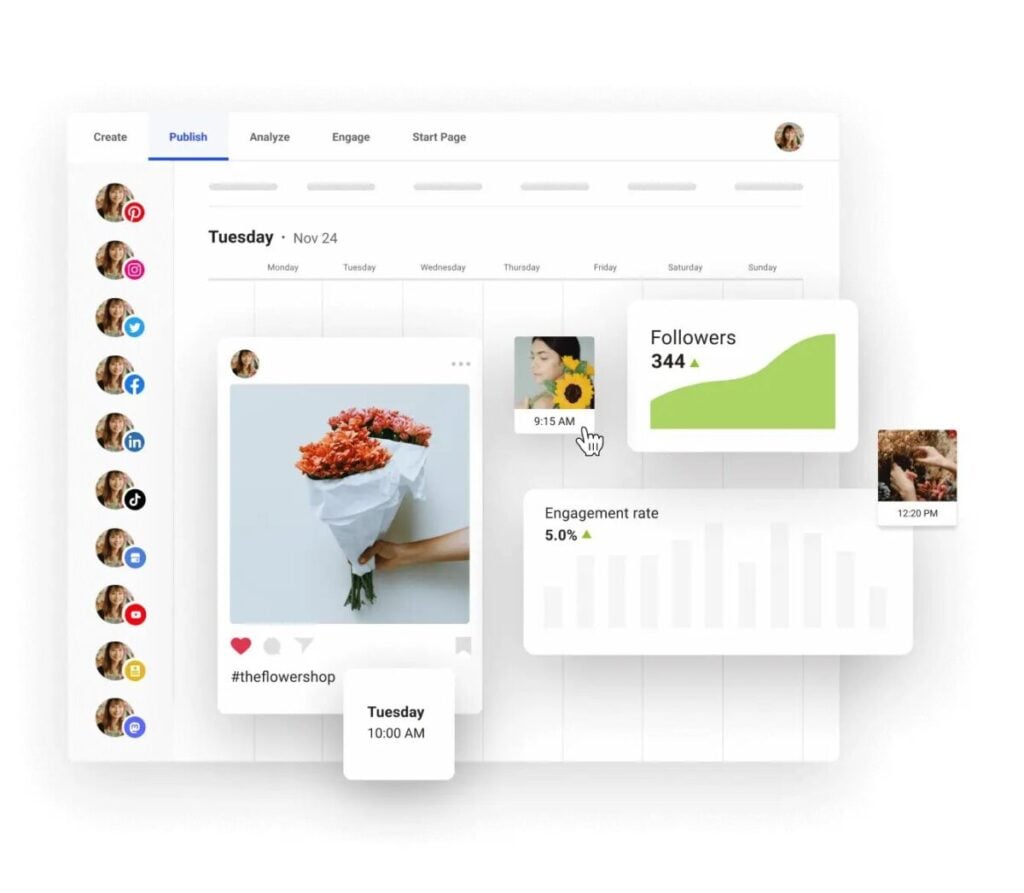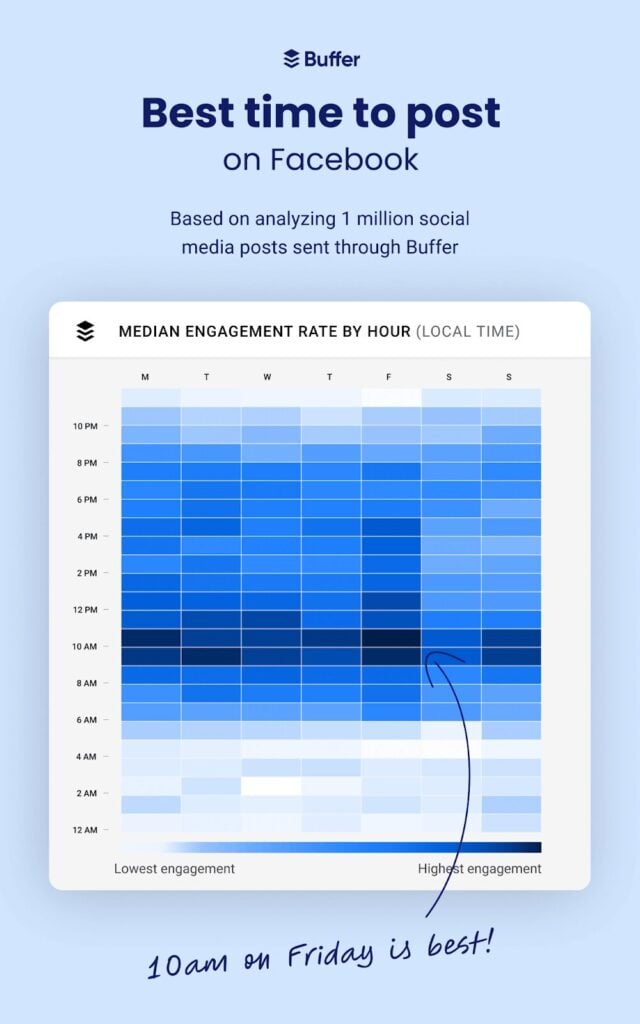There are over 5 billion social media users in the world, and most of them use 6+ social media sites every month. With such widespread use of these platforms, it's a given that social media marketing is a part of every business's overall marketing strategy.
But there's a catch: simply having a presence on social media is not enough. Businesses must leverage several tactics to make their social media presence actually count and drive results.
Since these tactics keep changing with audience interests and platform algorithms, staying on top of them can be tricky. In this guide, we'll take you through some social media marketing tactics that will keep you relevant for some time to come.
What Are Social Media Marketing Tactics?
In marketing, a ''tactic'' is an action you take. It could be as simple as automating posting on your social media or as complex as building a chatbot to handle customer interactions.
The aim of social media marketing tactics is to help meet your objectives. For example, if your primary goal is to increase brand awareness, a tactic you could use is influencer marketing.
Basically, you collaborate with ''influencers,'' social media users who have a considerable following, and ask them to promote your products or services.
Another example of a social media marketing tactic is using hashtags. Hashtags help to categorize your posts and make them more discoverable to a wider audience.
For example, Apple's #ShotoniPhone hashtag has nearly 30,000,000 Instagram posts.

Top Social Media Marketing Tactics for Businesses to Adopt
While all these social media marketing tactics are impactful, you don't have to dive in all at once. Instead, you can start with one or two, and then gradually incorporate more as you see fit for your business.
1. Tap Into Social Storytelling
Storytelling isn't an art limited to authors or filmmakers. Social media has given businesses an excellent platform to tell their stories.
Every brand out there is posting about its products. They're making video testimonials and posting stories about their journey.
How do you stand apart from the crowd? By telling compelling stories.
People are more likely to remember a good story than they are to remember an advertisement. You can use this to your advantage.
However, don't make your stories just about your products. Instead, make customers and social issues a part of these stories.
Jay Bayer, the author cum marketing strategist, says,
"If your stories are all about your products and services, that's not storytelling. It's a brochure. Give yourself permission to make the story bigger."
Humans of New York's Instagram account is an excellent example of storytelling done right. The account features real people and their stories, creating a strong emotional connection with the audience.
Another way you can use storytelling is to make your product the main appeal. Peter Guber, the CEO of Mandalay Entertainment, explains,
"A great salesperson knows how to tell a story in which the product is the hero."
A good example of this approach is Airbnb. The brand encourages hosts and travelers to share their unique properties and memorable experiences.
They're not simply sharing pictures of random places, but they're creating a narrative around the properties and their hosts. These are not Airbnbs located in a busy suburb but really unique properties like a log cabin, a carriage house in Denver, a greenhouse, an igloo, or a secluded tree house.
Who's the hero in this story? The Airbnb property, which is Airbnb's product.
You can also engage in storytelling using a brand mascot. Aflac's duck, Geico's gecko, Duolingo's owl, and Michelin Man are all memorable brand mascots that have been part of successful storytelling campaigns.
The Aflac Duck has its own Facebook page with 689k followers, where the brand posts informative and promotional content to show followers how its health insurance plans can help protect them and their families.
You'll see the brand using a lot of duck-related puns and duck-y graphics, but the underlying message of protecting your loved ones is always present.
The same is true for the brand’s Instagram page, too. Notice the consistency in storytelling across all channels. That’s what maintains brand familiarity in your target audience.
2. Stick to a Social Media Calendar
Many social media experts will tell you that you need to post at least a certain number of times every day or week, but the truth is, it's not a one-size-fits-all approach.
Each brand has its own target audience and social media strategy. Also, it's not always possible to post something every day on your six or seven platforms.
According to the Sprout Social Index, 74% of social media consumers think it's right for brands to post once or twice a day. But it's not just a matter of posting whatever you want, whenever you want.
You should have a social media calendar that outlines when and what type of content you'll post. In the same Sprout Social survey, it was found that of the most memorable brands on social media, 38% prioritize original content rather than trendy topics.
However, whatever you post has to be timely.
A social media calendar helps you accomplish this. It's even better if you use a tool that allows you to create a calendar and automate post-scheduling.
For example, Buffer has a simple social media calendar tool to schedule your posts for all platforms. It can also automate your posting schedule, so you don't have to manually post every day.

Buffer also offers suggestions on the best time to post. The information is based on your particular audience so you can reach them at the optimal time.
But if you only need a calendar template, you can use the free one from HubSpot.
3. Post at Optimal Times
It can be pretty disheartening to spend time and effort on creating an awesome social media post only for it to get 20 likes and no comments. Often, it's not the content of your post that's the problem but rather the time you chose to publish it.
Think about it. If you post at a time when most of your audience is asleep or busy with work, they're not likely to see your post.
So, how do you know when is the best time to post?
Again, this is where data and analytics come in. Platforms like Facebook and Instagram show you when your audience is most active. You can post during these times to increase the chances of your posts getting their due engagement.
Some industry benchmarks and research-based data also suggest optimal posting times for different platforms.
Buffer's analysis of over 5 million posts shows that the best time to post on Instagram is 7 am to 8 am on weekdays. Mondays and Fridays are the best days if you want to get more eyes on your posts.

If you're planning to post on LinkedIn, Thursdays and Fridays are the best days. Post between 9 to 5 pm on weekdays.

TikTok
For TikTok, Buffer found 4 pm to 5 pm mid-week to be the best time to post. Buffer reports,
"The best times to post on TikTok are 2 pm on Mondays, 4 pm on Wednesdays, and 8 am on Sundays."

While TikTok posts fare well on most days, Tuesdays are the most favored day, Saturday being the least.
Your Facebook post should be up at 10 am on a Friday for best results. Besides Friday, Monday and Tuesday are optimal times.

When looking for the best time to post, it's important to keep in mind your target audience and their time zones. For example, if your audience is primarily located in a different time zone than you, schedule your posts accordingly.
For example, most of the audience in the US is in the Eastern and Central time zones. So, you should base your posting schedule on these time zones.

4. Make Your Posts Shareable
Shareable posts tend to get more engagement since people are more likely to repost or share them with their network. So, what makes a post shareable?
Good visuals.
Canva is your best buddy in this regard. Create infographics or informative visual posts that your followers are likely to interact with and post on their stories.

Adding a fun factor to your posts also makes them shareable. For example, people love to repost memes.
So you can add a bit of humor to your posts. Maybe even add a pop culture reference in there. That's bound to get people to engage.
Take this post from Minecraft as an example. It's a meme with an in-game reference. The post has over 377,000 likes and 1,100+ comments.
Lyft also does a great job of creating shareable posts. The ride-sharing service posts relatable and humorous content on its Instagram account that gets comments and shares.
Every social media platform has a different convention for what classifies as shareable. On Instagram and TikTok, it's trendy stuff and humor, whereas on LinkedIn, it's professional content.
You have to adapt to the norms of every platform. Take Free People's social media accounts as an example.
On TikTok, the brand posts influencer collaborations and user-generated content (UGC). Since video content is dominating on TikTok, high-quality videos are more likely to get shared and reposted.
@freepeople
If you head over to its Instagram account, you'll see more product features and lifestyle content. Aesthetics are the key to Instagram success.
On Pinterest, the brand has created style inspiration boards and gift guides from its product selection, because that's what Pinterest users come to the platform for.

Source: pinterest.com
To no one's surprise, Free People is doing decently well on each platform. It even has over a million followers on Pinterest, which is an achievement only few of its competitors have managed to get.
A lot of this is due to the content being platform-specific and shareable.
5. Go Live on Social Media
A lot of bands overlook the importance of live streams for their social media strategy. But the truth is live streaming on social media platforms can be pretty beneficial to your engagement rate.
In fact, Facebook urges brands to use its Live feature. You can use it to hold Q&As, show product launches, exhibit behind-the-scenes footage of your band's creative process, etc.
Nearly 22.7% of global social media users watch live content. That's a significant chunk of your target audience.
Louis Vuitton was one of the first brands to host a live stream event. The event was hosted by Chinese influencers on Xiaohongshu, a popular Chinese social media platform.

In the live stream, the influencers showed the brand's new summer collection and offered styling tips. Spanning over an hour, the live stream has an engagement rate of 33%. Also, LV ended up getting 20,000 new followers on its official Xiaohongshu account.
Walmart also did something similar on TikTok. The brand's live stream was the first shoppable live stream of its kind in the US.
Walmart got 10 of the most popular TikTok influencers on board and used the in-app shopping features to sell products in real time.
It was a huge success, with Walmart getting 7x more views than it expected. Also, the brand's following on TikTok went up by 25%.
You can also do something similar.
Since both Instagram and TikTok now have social commerce features, you can run shoppable live streams, especially for new collections or limited drops.
6. Use Video Posts in Your Content Strategy
Video content is beloved by social media users because it's quick and easy to watch. Shorter videos tend to do better on social media.
Platforms like TikTok and Instagram are specifically made for short-form video content. For longer posts, use Facebook or YouTube.
HubSpot's data shows that 36% of marketers believe 1 to 3 minutes is the optimal length of a marketing video. Meanwhile, 27% of marketers say the video length should be between 4 and 6 minutes, whereas 16% of marketers say it should be under 60 seconds.

Of course, you'll have to experiment and see what works best for your audience. Some may prefer shorter, bite-sized videos, while others may be more engaged with longer, in-depth content.
Let's say you want to post video content on TikTok. Most users will prefer shorter videos.
Chipotle is a good example. The brand posts UGC and funny videos that are usually under a minute long.
@chipotle
These videos get hundreds of thousands of plays and likes.
Similarly, if you look at Glossier's Instagram account, you'll see that the Reels tab has a ton of videos about the brand's new products, advertising campaigns, UGC, and promotional content.
Again, these videos are usually under 60 seconds. It's also important to notice that the quality of these videos is exquisite, to say the least.
Again, that's a matter of platform conventions. People on Instagram are wooed by high-quality visuals and aesthetics.
On TikTok, it's more about relatable and fun content.
7. Automate Social Media Marketing
Automation is all the hype these days, and rightfully so. It takes manual labor out of mundane tasks and makes your life easier.
Why leave the automation to the industry giants? You, too, can automate your social media marketing efforts and save yourself time and effort.
One helpful tool in this regard is Sendible. You can use it to schedule a whole month of posts in advance.

Its collaborative features let you bring other team members on board for quick approvals and feedback. Sendible also has an analytics dashboard where you can see which of your social media sites is bringing in the most traffic.
The data also helps you find the best times to post and identify top-performing content types.
Content Studio is another cool tool that lets you schedule and approve social media content. Its analytics feature gives you demographic information about your social media followers.

You can schedule posts weekly or monthly, depending on your needs. Plus, Content Studio lets you see high-performing content in your niche to get inspiration for your own posts.
If you want to automate ad campaigns on social media, Loomly is an excellent tool. It lets you schedule when you want the posts to go live. You can also add UTM codes to your URLs to get automated insights on them.

Automation helps you stay consistent with your social media marketing and frees up your time. It also ensures that you have a post up every day, even if it's busy in the office or it slips your mind.
8. Work With Influencers
It shouldn't come as a surprise that influencer collaborations help boost your brand's online presence. People trust influencers, and you can capitalize on this through influencer collaborations.
There are several ways to do this.
First, you can launch a new product with an influencer or a group of influencers. The beauty brand Kosas did just that by collaborating with a beauty influencer to launch new lipstick shades.
The TikTok-famous beauty influencer Kensington not only promoted the lipstick on her platform but was also the muse for the photoshoot showcasing the new shade.
@kensnation
Another way to work with influencers is through sponsored content. Let's say you're a fitness brand.
You may collaborate with a fitness influencer to post sponsored content featuring your products. They could be wearing your branded gear or using your products in a workout video.
Such videos expose your brand to the influencer's audience. That helps bring more eyeballs to your products and can lead to more sales.
For example, Audible works with #booktok influencers and ''book-tubers'' to market its app. Jack Edwards, a popular YouTuber who makes videos about books, promoted the app on his TikTok account.
@jack_edwards [ad] I listened to so many stunning audiobooks this year — but these were my favourites!! get a free audible trial in my bio ✨ #MyAudible2021 ♬ original sound - Jack Edwards
The brand gave him a free trial link to put in his bio, so anyone who clicked on it got the free trial. Since the recommendation came from someone who is actually known to be a book lover, people were more inclined to check out the app.
Social media contests or giveaways are another effective way to work with influencers. You can team up with an influencer to give away products or services from your brand.
Here's how the rules might look:
- Follow both my account and the brand's page.
- Like this post.
- Tag 2 friends in the comments who would love to win.
The more people who participate, the more followers you get on social media.
Some brands also give discount codes to the influencer's followers. For example, you could offer 20% off on your product to customers who use the influencer's code.
For example, True Botanicals, a skincare brand, partnered with Avery Woods, a TikTok lifestyle and beauty influencer. The brand gave Avery a code that her followers can use to get 10% off their purchases.
@averyywoods A little sickness won’t stop me from glowing 💅🏼✨@True Botanicals #TrueBotanicalsPartner #AD #skincare #skincareroutine #glowyskin #selfcare #selfcareroutine #mom #momsoftiktok #momlife #vlog ♬ original sound - Avery Woods
If you don't have the budget for bigger influencers, work with micro-influencers. Their audiences are usually highly engaged, giving you a decent return on investment.
Go through our influencer marketing report to learn more.
Conclusion
Marketing on social media has become quite dynamic in the past few years. With TikTok's rise and the emergence of new platforms like Threads, it has become even more important for social media marketers to ride the trends.
Instead of taking a unifocal approach to social media marketing, it's better to combine a few tactics. Sure, you don't have to go all nine yards.
But a little variety can help you reach more people. Take inspiration from brands that are maintaining the right balance of video content, influencer marketing, and other tactics.
Then, test and try to find the right ingredients for your social media strategy.


